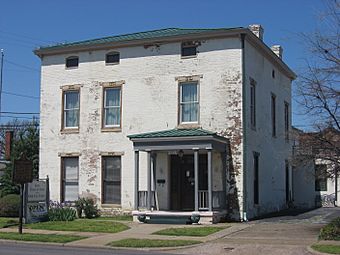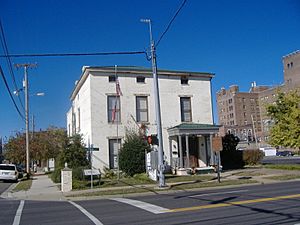Lloyd Tilghman House facts for kids
Quick facts for kids |
|
|
Tilghman-Woolfolk House
|
|

Front and side of the house
|
|
| Location | 631 Kentucky Ave., Paducah, Kentucky 42003 |
|---|---|
| Built | 1861 |
| Architectural style | Greek Revival |
| MPS | Caught in the Middle: The Civil War on the Lower Ohio River MPS |
| NRHP reference No. | 98000940 |
| Added to NRHP | August 13, 1998 |
The Lloyd Tilghman House is a special old house in downtown Paducah, Kentucky. It's also known as the Tilghman-Woolfolk House or the Lloyd Tilghman House and Civil War Museum. This historic home tells a lot about the past, especially during the American Civil War.
Contents
The House's Early History
Building the Home
This beautiful Greek Revival style house was built in 1852. A man named Robert Woolfolk had it built for Lloyd Tilghman. Tilghman and his family moved to Paducah that same year. At the time, Paducah was a town with about 3,000 people.
Lloyd Tilghman's Life
Lloyd Tilghman had studied at the United States Military Academy. He later became a civil engineer for a railroad company. His job was to help build the first railroad connecting Paducah to cities in the south. Tilghman, his wife, their seven children, and five enslaved people lived in this house until 1861. He spent some time working on a railroad project far away in Panama.
A Time of Change
In 1861, Tilghman was a colonel in the Kentucky State Guard. He left Paducah in June 1861. He wanted to make sure that officers who supported the Southern states would lead the state militia.
The Woolfolk Family and the War
After Tilghman left, Robert Woolfolk's family moved into the house. When U.S. soldiers arrived in Paducah, their main office was right across the street. Woolfolk showed his support for the Southern states by flying a Confederate flag. This caused a small riot in December 1861. U.S. soldiers, especially from the 11th Indiana Regiment, were involved. This event was part of a bigger shift in military leadership. Soon after, Ulysses S. Grant became more important than his superior, Charles Ferguson Smith.
Leaving Paducah
Later, in August 1864, U.S. Brigadier General Eleazer A. Paine ordered Robert Woolfolk to leave Paducah and the United States. He was sent to Canada. Two weeks later, Woolfolk's wife and family also had to go to Canada. Several other families from Paducah and Columbus, Kentucky, joined them in exile.
The House After the War
New Uses for the House
After the Civil War ended, the house was a family home until 1906. Then, it was used for different businesses for many years. In 1986, there were plans to tear the building down. However, a group called Growth, Inc. stepped in and saved it.
Becoming a Museum
In 1987, the roof was fixed to keep the house safe. By 1992, the Tilghman Heritage Foundation took care of the building. From 1986 to 1998, about $150,000 was spent to save and restore the house.
Today, the Tilghman House is a Civil War Museum. It focuses on the war's events in the western part of the country. The museum officially reopened on March 25, 2006. It highlights Kentucky's role in the Civil War. On December 1, 2008, the Sons of Confederate Veterans bought the house from the foundation. The museum continues to be open to visitors. You can visit from 12:00 PM to 4:00 PM, Wednesday through Saturday, from March to November.
Images for kids





